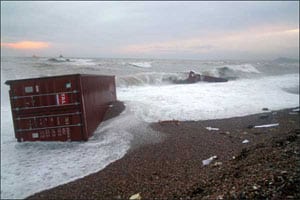 As companies seek to develop a foothold in new markets or source from lower-cost countries, supply chains are being stretched with tighter demands on cost, transit time and quality. These business models introduce new challenges, including multiple modes of transportation, customs, different currencies, several languages, laws, carriers and more importantly, longer supply chains.
As companies seek to develop a foothold in new markets or source from lower-cost countries, supply chains are being stretched with tighter demands on cost, transit time and quality. These business models introduce new challenges, including multiple modes of transportation, customs, different currencies, several languages, laws, carriers and more importantly, longer supply chains.
And the longer goods remain in the supply chain, the greater the risk from theft, damage, natural disasters and other challenges.
As modern supply chains are often global in scope and bear heavily on a firm’s fiscal health, supply chain risk poses a greater threat than any other business area. Risk factors include quality and safety challenges, supply shortages, legal issues, security problems and regulatory and environmental compliance.
Unfortunately, bad things can happen to good cargo. In fact, 52 containers are lost at sea each week. That statistic might not seem bad, until one of the containers is yours. While you might be saying, “that will never happen to me,” I can assure you it does.
As an example of how important cargo insurance is for companies, we were discussing coverage with a German company in 2013 and provided them a quote for cargo insurance. They rejected the quote and less than two weeks later, the Mol Comfort, a container ship, broke into two pieces off the coast of Yemen on its way to Rotterdam.
Approximately 2,000 containers took on water, and 1,700 of them were found floating. As a result, our potential customer lost nearly $150,000 in goods, leading to dissatisfied customers, lost sales and financial strain. Soon afterward, they came back asking us for a cargo policy. This is not an isolated incident, with more than $50 billion in global cargo losses each year.
Truck, ship and air cargo are the most vulnerable for losses and account for 84% of incidents. Actually, cargo moving by truck accounts for 43% of those incidents with the three most likely causes of damage including theft, rough handling and environmental conditions. In the United States alone there are 2.2 reported cargo thefts each day with an average value of $232,924. And, the threat of cargo theft continues to rise, given the ongoing sophistication of criminal groups and the relatively limited penalties associated with cargo crime.
The supply chain is the lifeblood of a business. Yet, more often than not, companies don’t take steps to identify or mitigate supply chain risks. In fact, a study published in Risk and Insurance magazine found that just 25% of a typical company’s supply chain is assessed in any way for risk. And none of the 110 respondents rated their company as “highly effective” at supply chain risk management.
Supply chain impacts can be daunting. Consider the following statistics from the Global Supply Chain Institute about companies that experience a major supply chain disruption:
- Decrease in sales of 93%
- Reduction in shareholder returns of 33%-40% over a three-year period
- Share price volatility increase of 13.5%
- Decline of 107% in operating income and 114% in return on assets
Overcoming a large loss can be discouraging. For example, if a truck with $232,000 in goods is hijacked, and the company had profit margins of 6%, it would need to sell almost $3.9 million in new goods to offset that loss.
Not every risk is controllable, but many can be identified with proper planning. And with diligence, contingency plans can be put into place to mitigate disastrous results. It is recommended that companies work with supply chain risk and business continuity professionals to help identify, prioritize and mitigate risks.
Initial steps include mapping the supply chain, especially modes and carriers used. You also need to assess the value of goods transported and how much they’re concentrated within a particular conveyance, taking into account routes traveled.
You may find that a particular supply chain node has too much risk and requires mitigation tactics, whether it involves reviewing the cargo policy or breaking the load into multiple shipments. We worked with a company that found they had more than $20 million in goods traveling from their distribution center on a carrier to the origin airport. While the threat of a plane going down is small, the risk of an accident with $20 million in goods getting to the airport was greater and required mitigation techniques.
Sadly, bad things can happen to good cargo. Don’t become a statistic. Reach out to supply chain risk partners to help you make the first step. They can help you identify and acknowledge your risks. Then take the time to establish processes and procedures to protect your business, your products and
your profit.
Dave Zamsky is vice president of marketing at UPS Capital